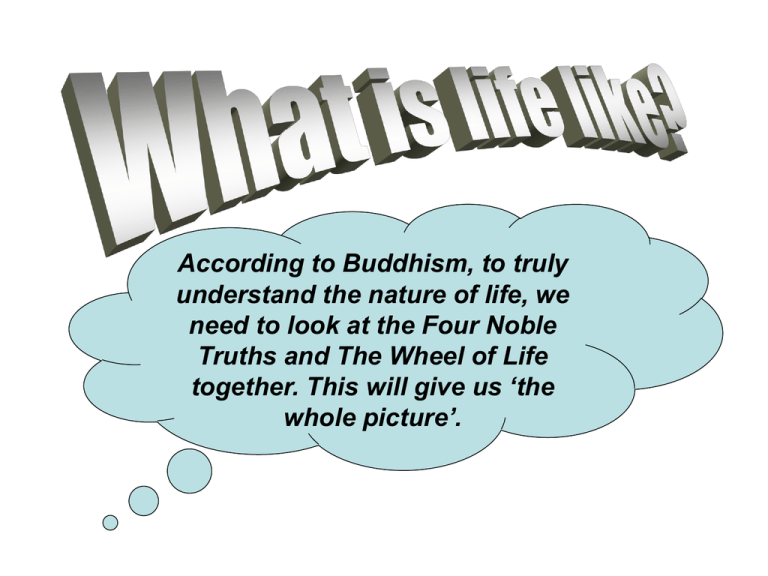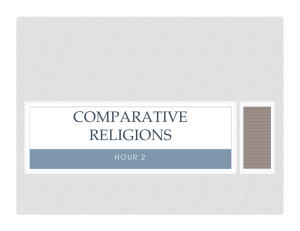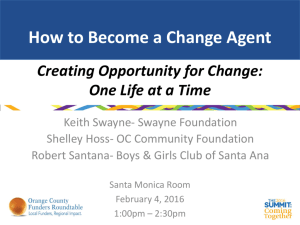What Is Life Like?
advertisement

According to Buddhism, to truly understand the nature of life, we need to look at the Four Noble Truths and The Wheel of Life together. This will give us ‘the whole picture’. This is the doctrine or teaching on Impermanence. This is the doctrine or teaching on no permanent self. Anatta Anicca Dukkha This is the doctrine or teaching on Suffering or Unsatisfactoriness Buddhists say that life is characterised by Three Marks of Existence. Buddhists describe life as impermanent and full of change. This is a crucial Buddhist teaching and one that we must understand. It has implications for our understanding of the rest of the Buddha's teachings. •‘Anicca’literally means ‘impermanence’ •It is the First Mark of Existence / Universal Truth •This means that everything is constantly changing •Nothing stays the same (nothing is permanent) This concept is at the root of all Buddhist belief – if you accept and understand anicca, you are on the road to enlightenment! “All created things perish” We can see Anicca in the life of the Buddha: 1. The Four Sights 2. The Great Renunciation 3. Search for the correct path 4. His travelling and teaching 5. His death. So is it real? Buddhists believe life is full of suffering. This suffering is mainly caused by people’s unrealistic EXPECTATIONS of things – wanting more money / wanting to be happy forever / not wanting to get old / etc. We resist change and are upset by it, we get upset when we don’t get what we want, etc. If we understand that everything is impermanent and will always change, we shouldn’t have these unreasonable expectations. We will always realise that good things come to an end, and also that bad things will also pass. This gives a realistic and truthful outlook on the world, and allows Buddhists to properly understand other Buddhist teachings. This literally means “no soul” This is Anicca applied to people. All Life is Suffering By looking at the centre of the Wheel of Life we can understand more about what causes us to suffer and what we can then do to stop it. The Wheel of life is a symbol of what life is really like. Just like a real wheel that turns, our life continually turns round and round until it is stopped. Just like a real wheel the Wheel of life turn at its centre or the axis. As human beings, it is how we are at the very centre of our being, that determines how our life will turn. Remember the analogy of the Doctor and the Cure!!! If we want to stop a Wheel turning we have to find the Cause, then stop it. The Cause of Suffering is Craving/Greed (Tanha) Greed / Craving Tanha Hatred / Aggression Ignorance The animals at the centre of the wheel represent the three poisons or the three fires. These fuel the wheel and help it turn. The animals are shown biting each other because they feed off each other and so cause each other. In order to stop the Wheel turning we need to stop feeding these fires and so stop suffering and recognise the true nature of life. We will then have achieved enlightenment and attained We attach ourselves to things and expect things to provide us with pleasure and satisfaction – when it does not we suffer. ANICCA ANATTA In Pali this is called Tanha. This is the Second Noble Truth. Give examples of the three types of craving!! The Buddha identifies three types of craving: (1)Craving for objects of sense pleasure (2)Craving for Existence (3)Craving for Non Existence BODILY PLEASURES SWEETS AND ALCOHOL LUXURY GOODS We place high expectations on these items as we assume that they will give us lasting pleasure. When they don’t we get upset and we then suffer. We get attached to the experience of pleasure and as we know this never lasts (Anicca). We will always want more and we are never satisfied. Our desire for an object may also increase the more we use it. This may cause us more suffering. This is the desire to be someone. We crave recognition and acceptance of who we are. We want people to recognise us a certain person. When they don’t recognise us as that person we suffer. We become upset and this may lead us to anger because we are ignorant of the truth. Even if we become that person it will not last forever – WHY…? …because of Anicca! Also remember that there is no permanent self so these times will not last forever. There are often times in life that we want to be a nobody and want to run away from the various situations that life has thrown at us. This again could lead us to do harmful or anger-fuelled actions because we have been ignorant of the fact that this will not last forever. (ANICCA) It is these actions that we have committed as a result of craving non existence that may cause us further suffering. DHAMMAPADA 334 – 342 If a man watches not for NIRVANA, his cravings grow like a creeper and he jumps from death to death like a monkey in the forest from one tree without fruit to another. And when his cravings overcome him, his sorrows increase more and more, like the entangling creeper called birana. But whoever in this world overcomes his selfish cravings, his sorrows fall away from him, like drops of water from a lotus flower. Therefore in love I tell you, to you all who have come here: Cut off the bonds of desires, as the surface grass creeper called birana is cut for its fragrant root called usira. Be not like a reed in a stream which MARA, the devil of temptation, crushes again and again. DHAMMAPADA 334 – 342 Just a s a tree, though cut down, can grow again and again if its roots are undamaged and strong, in the same way if the roots of craving are not wholly uprooted sorrows will come again. When the thirty six stream of desire that run towards pleasures are strong, their powerful waves carry away that man without vision whose imaginings are lustful desires. Everywhere flow the streams. The creeper of craving grown everywhere. If you see the creeper grow, cut off its roots by the power of wisdom. The sensuous pleasures of men flow everywhere. Bound for pleasures and seeking pleasures men suffer life and old age. DHAMMAPADA 334 – 342 Men who are pursued by lust run around like hunted hares. Held in fetters and in bonds they suffer and suffer again. In groups of no more than four – highlight the places in the source that describe the Buddhist teachings we have learned about i.e Tanha, Anicca, Anatta, Dukkha. Then rewrite the passage summarising the meaning or message the Buddha was trying to convey. DHAMMAPADA 334 – 342 If a man watches not for NIRVANA, his cravings grow like a creeper and he jumps from death to death like a monkey in the forest from one tree without fruit to another. And when his cravings overcome him, his sorrows increase more and more, like the entangling creeper called birana. But whoever in this world overcomes his selfish cravings, his sorrows fall away from him, like drops of water from a lotus flower. Therefore in love I tell you, to you all who have come here: Cut off the bonds of desires, as the surface grass creeper called birana is cut for its fragrant root called usira. Be not like a reed in a stream which MARA, the devil of temptation, crushes again and again. DHAMMAPADA 334 – 342 Just a s a tree, though cut down, can grow again and again if its roots are undamaged and strong, in the same way if the roots of craving are not wholly uprooted sorrows will come again. When the thirty six stream of desire that run towards pleasures are strong, their powerful waves carry away that man without vision whose imaginings are lustful desires. Everywhere flow the streams. The creeper of craving grown everywhere. If you see the creeper grow, cut of its roots by the power of wisdom. The sensuous pleasures of men flow everywhere. Bound for pleasures and seeking pleasures men suffer life and old age. DHAMMAPADA 334 – 342 Men who are pursued by lust run around like hunted hares. Held in fetters and in bonds they suffer and suffer again. The Buddha is teaching us about the roots or cause of craving. He compares craving to a creeper called birana. A creeper is supported by another structure but eventually overcomes it. It overcomes this structure until it starts to damage it – just like craving will start to damage us – it will cause us to suffer. Only by overcoming craving, or cutting out the roots, can we stop the cycle of rebirth and achieve enlightenment and Nibbana. Acts that are a result of hatred or aggressive acts will ultimately cause suffering. Harmful acts will result in you building up bad kamma and this will cause the wheel to continue turning. Medical Anger includes putting research shows that anger can cause bad The blame for something on effects on our health. someone else. These are acts like assault or physical abuse or active acts. These are acts like ignoring someone or more passive acts What does it mean to be ignorant of something? It means that you didn’t know any better or that you did not know the truth about something and didn’t bother to find out. IGNORANCE According to Buddhism, if we are ignorant then we do not know how things really are. As humans we are ignorant of the true nature of things,. We are ignorant of the Three Marks of existence. For Buddhists it is this ignorance that is the root of the other two poisons or fires. So how do they cause each other? IGNORANCE We do not know what true happiness is so we want what we think will make us happy. CRAVING We crave and Attach Ourselves to objects and ideas. When they don’t meet our expectations we get angry and suffer. A cycle of poisons that cause each other. ANGER ANGER TO IGNORANCE We are angry so we are further deluded by the true nature of things. We are aggressive to others because we have suffered and we do not understand the true nature of suffering. The Three Poisons work together and cause selfish action to take place. This keeps the Wheel turning and we are caught in the Samsaric Cycle. They cause even more suffering if we don’t stop them and because the wheel keeps on turning we still have to go through the suffering of life. We are the result of our own actions. The only way that we can stop it is if we realise the truth, and build up good kamma to move on… The Wheel turning is called Samsara. We are caught in this continual turning cycle of birth, life, death and rebirth. We want to stop this and achieve enlightenment. This type of existence is Samsara. The type of existence we are aiming for is Nibbana • It is a long process • It happens over time. • There have been numerous rebirths. • Innumerable past lives. • We wander aimlessly from life to life. The Six Realms of Rebirth and how a being moves through them. There are three good existences on the right and three bad existences on the left. So what is life like for a Buddhist? It is characterised by the three Marks of Existence and also by the fact that we are caught in the Wheel of Samsara. You will need to know about each of these things in detail. You should also be able to talk about these with references to sources.





